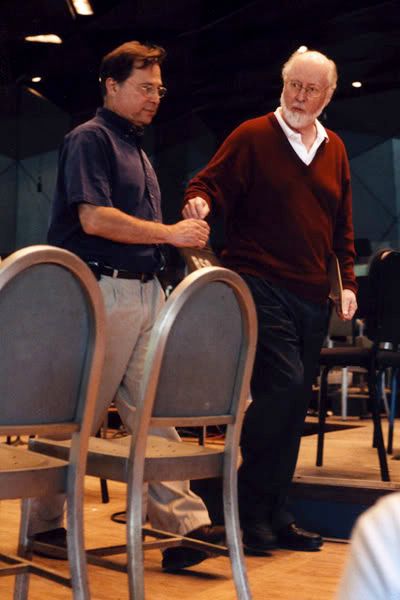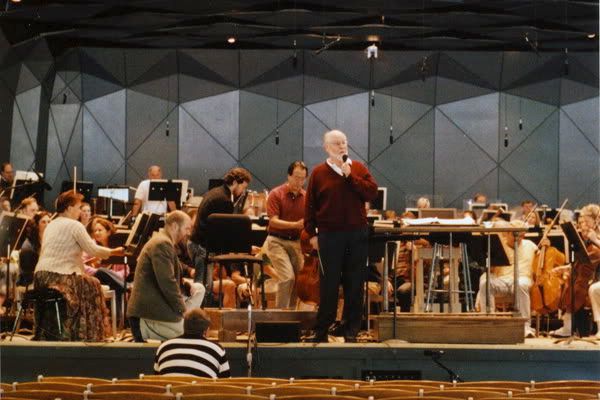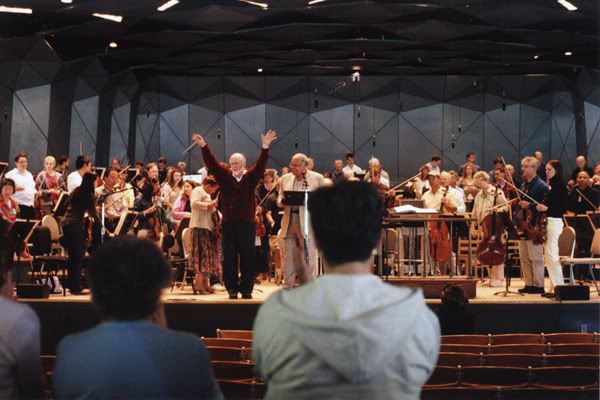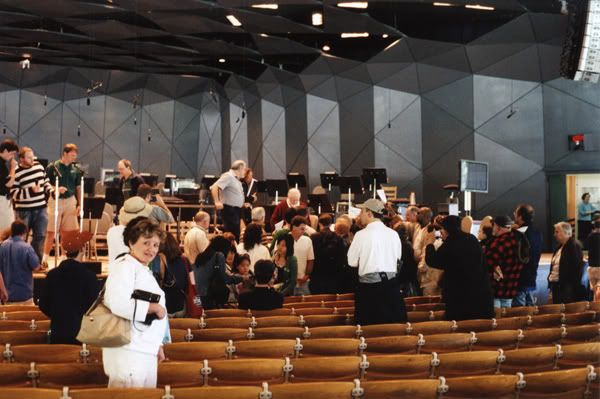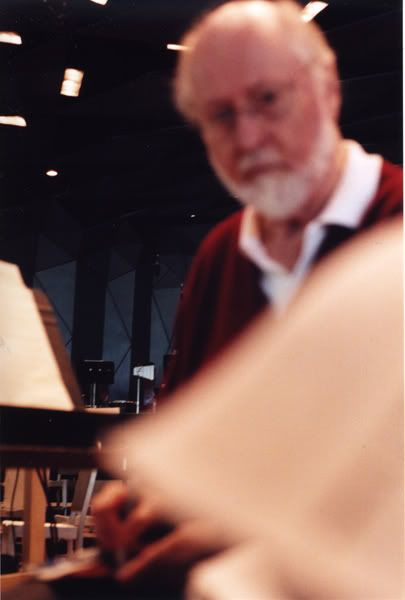Koussevitzky Music Shed, Lenox, MA
Saturday, August 12, 2006
The Boston Pops Esplanade Orchestra conducted by JOHN WILLIAMS
Yo-Yo-Ma, cello. James Earl Jones, narrator. Masakazu Yoshizawa, shakuhachi
“Film Night at Tanglewood”
CONCERT PROGRAM
– Sound the Bells!
– Excerpts from Close Encounters of the Third Kind
– “Escape from the City” from War of the Worlds
– Suite from Memoirs of a Geisha
Sayuri’s Theme, Going to School, The Chairman’s Waltz, Brush on Silk, Chiyo’s Prayer, Becoming a Geisha
– Grand Suite from Star Wars
20th Century Fox Logo, Main Title, Duel of the Fates, Across the Stars, Imperial March, Princess Leia’s Theme, Here They Come!, Yoda’s Theme, Parade of the Ewoks, Throne Room & Finale
(PICTURES FROM THE OPEN REHEARSAL AVAILABLE AT THE BOTTOM OF THE PAGE)
Concert Review by Richard Dyer (The Boston Globe)
Concert Review by Ray Kelly (The Republican)
Concert Review by Jacob Snyder *NEW*
On August 12th I attended both the Open Rehearsal and the actual Film Night at Tanglewood. It was an outstanding concert day, boasting not only John Williams and the Boston Symphony, but also appearances by Yo-Yo Ma, James Earl Jones, and—most unexpectedly—Steven Spielberg himself the night of the concert (he stood up from his seat after intermission and waved to the crowd, and he went up on the stage with Williams during the final applause).
I was particularly impressed by Williams’s energy throughout the day. I could tell that, even at 74, he still possesses an impressive amount of good health, strength, and creative energy. And judging from his new arrangements for this concert, his musical mastery has only improved throughout the years.
Before I proceed with a piece-by-piece analysis of the program, I’ll go ahead and recount my own personal experience on Saturday. I arrived at the open rehearsal about an hour before the pre-rehearsal talk, so I luckily got to sit in one of the best seats available. But the greatest delight for me was that Williams, after the rehearsal, took a seat at the end of the stage and began signing autographs. I was told that he never did this at Tanglewood, making it a particularly pleasant surprise. Yet he seemed to be signing pretty hastily, and he didn’t stay long enough to sign for everybody; but I was lucky enough to edge my way to the front with my small music notation book opened to the first page. I then timidly asked if he would write in a motif (“anything at all!” I remember saying to him) and he graciously wrote in the five-note Close Encounters motif (with dynamics markings and all!), smiled, and handed it back to me. This was no doubt the highlight of my day, and I meant to compliment him then on his new Memoirs of a Geisha Suite, but as it was my first time to ever stand before the Maestro, and as other fans fidgeted and knocked impatiently against my back, I simply thanked him and escaped the crowd. In the future I hope to attend some kind of CD signing or other event where I can say something with a little more substance than “thank you,” but hey, I have a motif from his own hand, so how can I complain?
The program:
1. Sound the Bells! – This was enjoyable for me because it was a different arrangement than what is heard on An American Journey. I don’t know whether this arrangement is brand new or not, or if it’s already released on a different CD. A really inspiring piece of music though.
2. A concert arrangement of “Escape from the City” from War of the Worlds, which segued into a shortened concert suite from Close Encounters of the Third Kind. It was mentioned in the pre-rehearsal talk that Williams likes to organize his concerts thematically, and I found the segue from a film about hostile alien encounters to one of peaceful alien encounters to be thematically appropriate on Williams’s part, especially since both scores possess such interesting comparisons in orchestral effects and colors.
Honestly, I thought that “Escape from the City” could have been played more aggressively (the performance on the soundtrack seems to do this better), but the Close Encounters Suite was excellent, ending triumphantly with the end credits music from the film, with a gentle sounding of the 5-note motif–meaningful to me, since this is what Williams wrote in my notebook ;)
3. Suite from ‘Memoirs of a Geisha’ – This was my favorite part of the program. First off, it is a brand new arrangement, and I believe the performance at the open rehearsal was the first time any orchestra ever played the suite. The music unfolded almost as a concerto, complete with cadenzas. I could tell that Yo-Yo Ma and Williams were really thrilled to be playing this music as they kept glancing excitedly toward each other during particular passages. There really was an inspiring musical kinship between the two throughout the suite, especially during “Going to School” and “The Chairman’s Waltz,” the latter piece performed beautifully by BSO concertmaster Tamara Smirnova, her violin set against Ma’s cello (much different than what you hear on the CD). Another highlight from the suite was “Brush on Silk,” which must be a real challenge to perform since the orchestra had to rehearse certain passages of it several times at the open rehearsal. The performance of it at the actual concert, however, was superb, and it was Ma’s opportunity to show off a bit, playing what was originally written for the Japanese Koto on pizzicato and staccato cello.
I was also very impressed by Ma’s awareness of and connection with the rest of the orchestra. He was continually smiling and communicating, through gestures and facial expressions, to other orchestra members, and overall he seemed to be particularly aware of the music as a whole and not just his own playing. I have never seen him live before this show, and now I can understand his popularity: not only is he a skillful performer, but his powerful display of confidence and his contagious sense of fun reminds everyone just what music is all about.
I really cannot say enough about this concert suite. Williams developed the material from Memoirs into what I consider to be the most lush and skillfully orchestrated arrangement of any film score he has written, with the melodies brilliantly woven between solo and orchestral passages. This music deserves a permanent place in the classical repertoire.
4. The Grand Suite from ‘Star Wars’ – This part of the program was basically concert pieces from the six Star Wars films with James Earl Jones narrating between them and film montages playing during selected pieces. Of particular interest to me was the orchestral arrangement of Duel of the Fates, which was played with an aggressive energy perfectly fitting the piece. I was also really delighted to hear a reference to Vader’s Theme played as an ostinato during this arrangement (I don’t believe that reference was in the original CD version, unless I just missed it).
On a negative note, I wasn’t terribly impressed with James Earl Jones’s performance. He seemed tired and detached both at the rehearsal and at the concert, and he made at least four mistakes during the actual performance (which included his now infamous “Long agooooo…. A long time ago…”). I’m not sure if he’s simply a poor narrator—which seems unlikely for someone like James Earl Jones—whether he is going slightly senile, or whether he simply didn’t care, but his performance was an overall disappointment.
But on the positive side, I was infinitely impressed with the Boston Symphony’s performance of Star Wars music. I typically associate the sound of Star Wars with the London Symphony, but the BSO performed with a kind of pomp and orchestral clarity that was perfect for a galaxy far, far away.
A certain aspect of the program I was unimpressed with was the montage footage during the Memoirs of a Geisha and Star Wars suites. With Geisha I won’t complain too much. After all, it has to be extremely difficult to make a bad montage when you have Dion Beebe’s cinematography to work with, but there were some awkward aspects to the montage–one being an excess of very slow motion (which I assume the editor chose to do because of the very atmospheric, reflective solo passages Ma was playing), and the other being a freeze frame of the young Chiyo running down a passageway. As for Star Wars, the montage was all right except for Princess Leia’s Theme. For one, I simply have trouble with the sweetness of the flute passages while hearing Leia speak lines such as, “Would someone get this walking carpet out of my way?!” And for some reason I cannot comprehend, the editor chose to show, at the grand and heroic climax of the theme, Alderaan being blown to smithereens by the Death Star. Why would you show tragedy accompanied by music of elegance and grandeur? It was simply bizarre, even distasteful from a narrative point of view. But I can easily let all of this go, since the music was what I was really there for.
As can be expected, the crowd gave Williams a roaring applause at the end of the concert, seeming to want to applaud him for the rest of the night. Williams then played one encore—the Flying Theme fromE.T., and then a spotlight of the famous Amblin’ logo soared across the walls of the stage. Williams pointed to the spotlight and turned to the audience with a humorous look of surprise and delight, and then he waved at the image to the laughter of the audience. Then after the encore and much more applause, the Maestro motioned that he was tired, so he and the orchestra took their last bow and departed.
The 2006 Film Night at Tanglewood was for me a musically inspiring and creatively energizing experience. I cannot wait for next year’s, and every Williams fan should be anticipating a CD release of the new Suite from Memoirs of a Geisha.
— Jacob Snyder
Concert Review by Angela Rose
I have just recently returned from last night’s performance in Tanglewood; the program consisted of John Williams conducting the Boston Pops in a two-act performance of selections from War of the Worlds, Close Encounters of the Third Kind, Memoirs of a Geisha, and Star Wars.
The evening started off with Sound the Bells!, a bellicose and triumphant piece celebrating a significant 1993 marriage in Japan. It was an amazing piece; one I know that I would want to get married to, and Williams’ brilliant style was easily recognized within it.
Afterwards was a piece from War of the Worlds where the deep horn blasts reminded me of the alien machines in the movie and the horror of their destruction. Thus, proving Williams’ amazing talent; he can instantly call upon a given emotion with a flick of his conductor’s baton. He then moved right into the theme from Close Encounters of the Third Kind, which is always a good choice J.
Next was the suite from Memoirs of a Geisha. Williams introduced master cellist Yo-Yo-Ma and they were off to the races. Yo-Yo-Ma produced a brilliant sound for the strains in “Sayuri’s Theme” and was able to smoothly move into the effervescent sounds of “Going to School”. “The Chairman’s Waltz” (my favorite) was up next and a woman from the Boston Pops did her best to do the piece justice. In my opinion she was pretty good considering she had to live up to Itzhak Perlman’s performance. Up next were “Brush on Silk”, “Chiyo’s Prayer” and “Becoming a Geisha” but they were extremely interwoven that it was hard to tell which piece exactly they were playing (not to mention they brought down a screen and played silent clips from the movie to entertain the audience; personally I would rather watch Williams at work but there you go).
Intermission.
At the start of the second part of the program, Williams pointed out the presence of filmmaker Steven Spielberg in the audience. Spielberg, dressed in casual clothes and a beret-type hat, stood up and waved to the crowd and received a great deal of applause.
After James Earl Jones was introduced as the narrator of the suite from Star Wars, he began with a familiar sounding narration which I later realized to be the same exact script that was used by Ian McDiarmid in the “Star Wars: A Musical Journey” DVD. Williams started the Pops on the 20th Century Fox Fanfare and in the moment between that and the main theme, Jones said, “Long agoooooooo–a long time ago in a galaxy far, far away.” People laughed; personally I felt kind of bad for the guy but what could you do? The main theme commenced and it was utterly amazing as it always is. Next up was “Duel of the Fates”, one of my favorites, which wasn’t as good as the recording due to the lack of a chorus; however the fact that I was watching my favorite composer conduct one of my all-time favorite songs was enough to keep me happy. The screen previously used for “Geisha” came down again and they played the “Duel of the Fates” video from the “Musical Journey” DVD along with the music. The night went on in the same fashion; Jones would narrate and then a well-known theme would play. Luckily the screen was used for every other song, rather than for all of them, so that Williams and the Pops would get some attention. Songs performed included “Across the Stars”, “The Imperial March”, “Princess Leia’s Theme”, “Tie Fighter Attack” (not “The Asteroid Field” as reported in the program), “Yoda’s Theme”, “Parade of the Ewoks”, and “The Throne Room/End Credits”.
A well-deserved standing ovation followed the final note of the suite and Williams bowed, coming on and off stage a couple of times. Being the generous man that he is, he came back and performed the theme from E.T. for an encore (again, always a good choice). At the climax of the piece, a round spotlight with a figure of the boy on the bicycle shone and moved across the back wall of the stage. Admittedly it was cute and it received an excited response from the audience. When the piece finished, amid all the applause, Williams brought Spielberg onstage and after a great deal more applause from the audience the night was over. Being an avid “Star Wars” soundtrack fan, and also a fan of the “Geisha” music, I have to say that it was a most amazing night of music.
— Angela Rose
Some pics from the early morning rehearsal, by JWFan member ‘Sulky’
Maestro introducing Yo-Yo Ma.
JW (w/ James Earl Jones to his left) receiving a standing O at the end of the rehearsal.
The autograph-seeking mob swarming JW by the stage.
Signing stuff x2.
Signing my JFK CD cover.
Exiting stage right.
